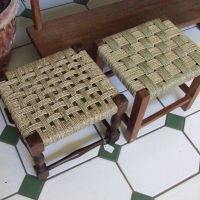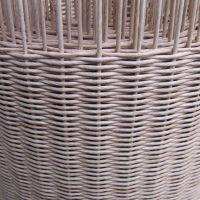Other Weaving Cords
There are many other cords and patterns used on chair seats, everything
from jute and cotton string to nylon washing line! But one of the most
familiar and popular is seagrass, this is made from strands of a marsh
grass or rush twisted together into a two or three ply rope. It is
surprisingly strong and can be woven into many different patterns to
give a firm but pliable seat. The only pattern it does not really work
well in is the traditional envelope rush pattern, because it is so hard
and round it tends to roll and sag with time.
Another popular seating cord is Danish cord. It is a fine, smooth natural paper fibre coil made famous by the sophisticated Scandinavian designers of the mid twentieth century. The most used pattern was a "two by two" basket weave hooked onto nails under the seat rails. The rails are usually quite deep and partially finished. Hans Wegner also designed some chairs with the cord woven in the traditional rush pattern, these chairs have rounded dowel like rails, the side rails being much higher than the front and back.
If you would prefer someone else to do the work for you please visit the Former Glory seat restoration page
Another popular seating cord is Danish cord. It is a fine, smooth natural paper fibre coil made famous by the sophisticated Scandinavian designers of the mid twentieth century. The most used pattern was a "two by two" basket weave hooked onto nails under the seat rails. The rails are usually quite deep and partially finished. Hans Wegner also designed some chairs with the cord woven in the traditional rush pattern, these chairs have rounded dowel like rails, the side rails being much higher than the front and back.
If you would prefer someone else to do the work for you please visit the Former Glory seat restoration page






